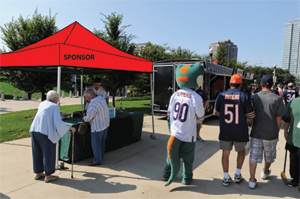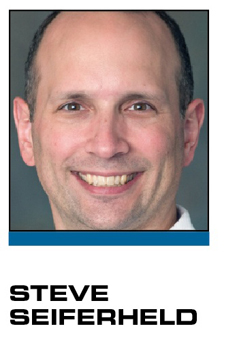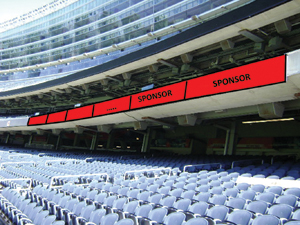Since joining the sports and entertainment industry, I have actively monitored the evolution of the corporate partnership space — specifically, the expectation among brands for the properties to demonstrate how the partnership improves key performance indicators. The measurement process can take all sorts of forms, including consumer research, impression counting and, of course, ROI calculation.
Recently, Turnkey Intelligence had the chance to partner on an innovative approach to helping brands maximize partnerships.
The Chicago Bears contacted Turnkey regarding a joint project involving a sponsor inventory study. A consumer research study, conducted via online surveying, measured the association of Solider Field’s array of marketing inventory and the brand benefits seen by corporate partners. Game attendees were invited to complete the survey, with a sweepstakes as an incentive. The study accumulated just under 500 respondents.
Partner recall, aided and unaided, served as the response variable and formed the basis for all comparisons within the study. Why focus on recall? Recall forms the top of any brand’s purchase funnel, and it’s the trigger for consideration, trial, repeat and advocacy. While some partners have found creative ways to educate fans about their brands, many still rely on basic signage with logos and colors. Expecting a logo to drive anything beyond recall is somewhat unfair.
Specific topics of interest within the sponsor inventory study included:
■ How did asset location factor into the recall equation?
■ What does incremental investment buy a brand?
■ How many fans are truly affected, and who are they?
The study ran throughout the 2012 NFL regular season. The Bears’ fan-marketing and research team, led by Elaine Delos Reyes, provided Turnkey with all relevant information pertaining to partner activation, including schedules for on-site display, game-day and stadium title sponsorships, and signage rotation for all eight regular-season home games. Having this schedule allowed us to marry brand identification and assets responsible for making attendees aware. The project yielded some valuable findings, laid out as follows.
■ They say in real estate …
It’s about location, location, location. To be clear, the sponsor inventory study did not identify any bad advertising locations within Soldier Field. But certain locations stood out by correlating with higher partner recall. For instance, consider the video board. Analysis established a clear linear relation between video board airtime and recall (i.e., brands with more minutes of video board airtime scored higher recall). In addition, respondents identified the slot of time after warm-ups but before game action as when they were most apt to have their eyes on the video board, suggesting that having airtime during this slot might offer incremental gains.
 |
Renderings shown to study respondents show two factors that affected Bears fans’ recall: activation and (below) video board airtime.
Photo illustrations by: Turnkey Intelligence
|
Brands that can afford the luxury of multiple advertising locations noticed higher recall from the increased exposure. The sweet spot seemed to be four: Once a partner hit four or more locations, recall jumped sizably. Why are multiple locations so vital? Consider that 54 percent of respondents agreed that they “wanted to support companies whose brands appear at Bears home games.” (That’s quite high, compared to Turnkey benchmarks.) The way for brands to enable that support among attendees is to make it as convenient as possible for fans to learn about the brand. If a partner’s only activation location is at Gate C hidden behind a hotdog cart, common sense
suggests recall will be quite low.
Driving recall is not just about multiple locations, but also about strategically choosing them. Analysis revealed that attendees interacted most frequently with brands on the same level as where they sat. While the finding might not be that surprising, how many brands target their activation or advertising based on the demographics of the general seating area? Club seating draws the interest of luxury brands. If I were marketing an economy car, I’d be looking at inventory away from premium seating.
■ You just HAD to be there!
Rather evident from the sponsor inventory study was the relationship between on-site display and recall. The study produced a de facto segmentation of Bears game attendees. Twenty-seven percent of respondents acknowledged interacting with one or more brands by visiting on-site activation. Because people self-select this interaction, we believe there are some people who simply enjoy meandering through partner displays in search of information (or swag). Busier areas such as stadium entrances and concourses drove much of that interaction. This level of interaction represents the reality of event marketing. Unless a brand is giving away cash, it’s best to identify multiple locations for on-site activation to generate a noticeable lift in recall.
■ Being in the Hall Of Fame
Like many teams, the Bears offer different tiers of partnership investment, with their highest level being a Hall of Fame partner. This platform amplifies their most important, integrated marketing partners. The Bears offer their HOF partners broader intellectual-property usage rights, integration into design aspects of Soldier Field, exclusive hospitality and more. One return on this top-tier partnership seems to be higher brand recall. Factoring in everything, HOF partners saw aided recall levels at twice the level of the next closest category.
The results of this project have provided the Bears valuable insight usable for adding value to corporate partnerships. “If a corporate partner approaches us with a goal of increasing recall of their stadium activation by X percent, we now have a template by which to craft that plan,” said Chris Hibbs, Bears vice president of sales and marketing. “We know that the video board belongs as part of any significant partner investment and that a fully integrated program at Soldier Field requires multiple points of engagement between partners and fans.”
A new season will bring new partners, updated activation and fresh inventory to Soldier Field, which is why the Bears will be repeating the study for the 2013 season.
Steve Seiferheld (steveseiferheld@turnkeyse.com) heads the custom research division of Turnkey Intelligence. Follow him on Twitter @SteveSeiferheld.






